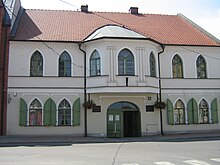|
Wolsztyn
Wolsztyn [ˈvɔlʂtɨn] (German: Wollstein) is a town in western Poland, on the western edge of Greater Poland Voivodeship. It is the seat of Wolsztyn County, and of the smaller administrative district of Gmina Wolsztyn. GeographyThe town is situated within the historic Greater Poland region, located on the small Dojca river, a headstream of the Obra, about 72 kilometres (45 mi) southwest of Poznań. The municipal area includes a large lake (Jezioro Wolsztyńskie; Wolsztyn Lake), next to which is a palace built in Classical style in the early 20th century, now used as a hotel and restaurant, and a park. Nearby tourist destinations include the Pszczew Landscape Park and the Przemęt Landscape Park. History The current settlement was established about 1285 on a causeway across the swampy Dojca River, probably by Cistercian monks descending from Obra Abbey. It developed as a centre of wool trade and cloth manufacturing on the road from Poznań to Lusatia, vested with market rights in 1424. Wolsztyn's town privileges were confirmed in 1519. It was a private town of Polish nobility, administratively located in the Kościan County in the Poznań Voivodeship in the Greater Poland Province of the Kingdom of Poland.[1] A route connecting Warsaw and Poznań with Dresden ran through the town in the 18th century and King Augustus III of Poland often traveled that route.[2] It was annexed by Prussia in the course of the Second Partition of Poland in 1793. After the successful Greater Poland uprising of 1806, it was regained by Poles and included within the short-lived Polish Duchy of Warsaw, and after its dissolution in 1815 it was reannexed by Prussia, as part of the Grand Duchy of Posen. Wolsztyn, then called Wollstein, was the district capital of Kreis Bomst, a Prussian district which, at the time, had approximately equal numbers of Poles and Germans. With the Prussian Province of Posen it became part of the German Empire in 1871 and a target of the Germanisation policies carried out by the German Eastern Marches Society (Hakata). After World War I, in November 1918, Poland regained independence as the Second Polish Republic, and the town returned to Poland several weeks later, when it was captured by Polish insurgents on January 5, 1919 during the Greater Poland Uprising.[3] With the 1939 Invasion of Poland, which started World War II, the town was occupied by Germany on 7 September 1939[4] and directly incorporated into the Nazi German Reichsgau Wartheland until the end of the war in 1945. The Polish population was subjected to various crimes, including arrests, expulsions and deportations to Nazi concentration camps. The Germans established and operated a prisoner-of-war camp for Polish POWs in the present-day district of Komorowo, which then served a transit camp for expelled Poles from the region, and was eventually converted into the Stalag XXI-C POW camp for Polish, French, British, Italian, American and Norwegian POWs.[5] The occupiers also operated a Nazi prison,[6] and a forced labour camp for Jews.[7] Notable Polish sculptor and painter Marcin Rożek, who lived and worked in Wolsztyn, was arrested by the Germans and then imprisoned in the Fort VII in Poznań and the Auschwitz concentration camp, where he died in 1944.[8] The Polish resistance movement was active in the town and its environs. From 1975 to 1998 it was administratively located in the Zielona Góra Voivodeship. SightsThe town has a Baroque parish church of the Immaculate Conception dating from the 18th century, a historical palace of the Gajewski and Mycielski noble families, which now houses a hotel, with an adjacent park, as well as several museums. Locomotive depot The railway line from Wolsztyn to Zbąszyń opened in 1886. The locomotive roundhouse in Wolsztyn is the only place in Europe to supply standard gauge steam locomotives for regular, timetabled train services on the national railway network. As of Autumn 2023 these services run to Leszno and Poznań, using timetabled steam engines. The site also includes a railway museum featuring restored locomotives. Since 1993 the Polish State Railways organises an annual parade of locomotives, which takes place at the start of May. The 2007 event, which also celebrated the roundhouse's centenary, attracted about 20,000 visitors. The local (Polish) website has up-to-date information about services/events. SportThe town is best known for its handball team KPR Wolsztyniak Wolsztyn. The local association football team is Grom Wolsztyn.[9] Major corporations
International relations Twin towns — Sister citiesWolsztyn is twinned with:
Notable people 
References
External links
Media linksWikimedia Commons has media related to Wolsztyn. Wikivoyage has a travel guide for Wolsztyn.
|
||||||||||||||||||||||||||||||||||||||||||||||





